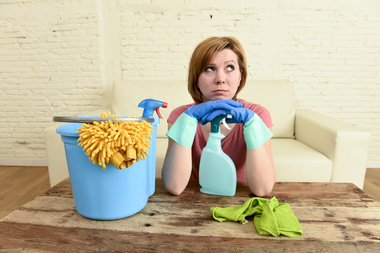On average, we’re spending more than 30 minutes less time cleaning a week than we did in 2014, according to research by Mintel. Why? Part of the reason is that we’re using multitasking products and cleaning equipment more to get the jobs done more quickly. Smart move, we say!
While there’s no substitute for a super-efficient vacuum cleaner to whiz through the housework, there are plenty of other household items you’re more than likely to have that double up perfectly for cleaning chores.
The brilliant household multitaskers:
1. A blunt knife
You’ll need this for dry-scraping off any solid or bulky part of a stain before treating it further. On delicate items, take care not to scratch or damage the surface.
2. Clean toothbrush
These are useful for brushing off powders, such as talc or cornflour, that have been sprinkled on an oily stain as an absorbent. Only use a soft brush that won’t damage delicate fabrics. Old toothbrushes are also perfect for scrubbing mould stains off grout.
3. Cotton buds
Ideal for cleaning small, delicate items. Use to dab gently at a stain to lift it. They’re also great for cleaning along your computer keyboard and removing the dust from the vent at the back of your hairdryer.
If the zip on your jeans doesn’t run smoothly, try dipping a cotton bud in a little vegetable oil and running it along the teeth of the zip to ease the track.
Use these when a light touch is required or the stained area is very small. Dab gently at the stain to lift it.
4. Glycerine
Available from most supermarkets, glycerine is great for softening and losening stains. Dilute it with one to two parts of water and apply to the stain. Allow the item to soak for an hour before washing as normal.
5. Ice cubes
Essential for removing soft, sticky stains such as candle wax and chewing gum. If you can place the stained item in the freezer, do that. If not, place an ice cube on the affected area and leave until the solid part of the stain is brittle enough to be picked or scraped off with a blunt knife.
6. Nail polish remover
The only thing that can remove a nail polish stain and even then when the stain is small. Don’t use on acetate fabrics, though, as it can damage them.
7. Soda water
Pouring bubbly water on pigment-based spills, such as red wine, helps to force the stain out of the fabric fibres – handy for emergency action at a dinner party. However, only use makes that are low in salt, otherwise you may inadvertently end up setting the stain!
8. Rubber gloves
Ideal for removing pet hair from your sofas, chairs or car upholstery. Put the gloves on and rub them over the furniture to gather the fur. Then, the quickest way to remove the fur from the gloves is to submerge your gloved hands in a basin of hot water. The fur will float to the surface.
Rubber gloves are also great for getting surface fluff off trousers if you’re on your way out and already in them!
9. Sticky tape
Sticky tape is ideal for lifting pollen particles off clothing and carpets. Gently pat the affected area with the tape to remove as much of the debris as possible. This method also works well for removing other dry debris, such as pet hair.
10. Paper towels
Use white paper towels to blot and soak up moisture in water-based stains. Avoid using patterned or coloured towels and clothes for this job – they could transfer dye and make the stain worse.
Paper towels are also useful if you have dried-on candle wax on tablecloths or even clothing. Place a paper towel over the wax spill (once it’s dry), and gently iron over with a cool iron. The wax will lift into the paper towel and away from the fabric.
All rights reserved to the initial publisher for Good Housekeeping.
Collected and published by Arms &McGregor International Realty® editorial team. Get in touched with us at [email protected]

